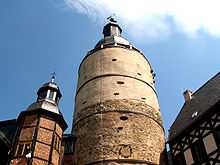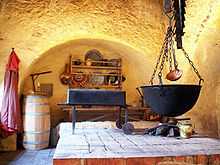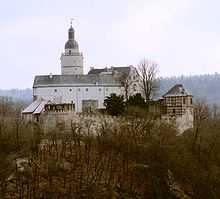Falkenstein Castle (Harz)
| Falkenstein Castle | |
|---|---|
| Burg Falkenstein | |
| Falkenstein, Saxony-Anhalt | |
|
Falkenstein Castle | |
 Falkenstein Castle | |
| Coordinates | 51°40′54″N 11°15′54″E / 51.68167°N 11.26500°ECoordinates: 51°40′54″N 11°15′54″E / 51.68167°N 11.26500°E |
| Type | Hilltop castle |
| Site information | |
| Condition | Preserved or largely preserved |
| Site history | |
| Built | 1120 and 1180 |
Falkenstein Castle (German: Burg Falkenstein) is a German hill castle in the Harz mountain range, dating to the High Middle Ages. It is located in the town of Falkenstein between Aschersleben and Harzgerode.
Location
The castle lies at a height of about 320 m (1,050 ft) above the Selke valley near the village of Meisdorf in the Harz district, in the German state of Saxony-Anhalt. It is located within extended forests, today a protected area (Naturschutzgebiet). Also nearby are the ruined medieval castles of Ackeburg and Old Falkenstein Castle.
History

Falkenstein was built between 1120 and 1180 and has been modified frequently since then, but still retains the character of a medieval castle. It has a commanding location and was never captured.
According to legend, Falkenstein Castle has its origins in a murder: around 1080, the Saxon nobleman Egeno II of Konradsburg slew Count Adalbert II of Ballenstedt in a fight, whereupon the murderer was allegedly made to give his family seat up to be converted into a monastery. As a result, Egeno's son, Burchard of Konradsburg, had the new Falkenstein Castle built.
In 1220, during the reign of Prince Henry of Anhalt the Anhalt ministerialis, Eike of Repgow, from what is now Reppichau, drew up here the Sachsenspiegel the first German law book. The book is dedicated to its commissioner, Hoyer of Falkenstein. In 1437 the castle was given as a fief by the Bishopric of Halberstadt to the House of Asseburg, in whose hands the castle remained until its confiscation after the Second World War.
Present use

Today the castle and its museum are one of the most popular destinations in the Harz mountains. It is part of the Romanesque Road. The castle has a falconry and a restaurant that offer traditional 'knightly' food (Ritteressen).
The castle was one of several backdrops in the seven-part children's series shot by GDR television, Spuk unterm Riesenrad, and one of the locations for the DEFA fairy tale film Schneeweißchen and Rosenrot ("Snow White and Rose Red"), as well as films in the GDR series Polizeiruf 110 The Entdeckung.
The castle is No. 200 in the network of hiking checkpoints known as the Harzer Wandernadel.
Sources

- Sven Frotscher (1995) (in German), Burg Falkenstein and Schloss Meisdorf, Leipzig: Ed. Leipzig, ISBN 3-361-00434-9
- Boje Schmuhl, ed. (2006) (in German), Burg Falkenstein, Dössel: Stekovics, ISBN 978-3-89923-131-1
- Winfried Korf (1997) (in German), Burg Falkenstein, Wettin: Stekovics, ISBN 3-929330-79-2
- Berent Schwineköper (Hrsg.): Provinz Saxony Anhalt. In: Handbuch der Historischen Stätten Deutschlands. Band 11. Alfred Kröner Verlag, Stuttgart 1987, p. 117–118, ISBN 3-520-31402-9
See also
External links
| Wikimedia Commons has media related to Falkenstein Castle. |
- Falkenstein Castle
- Old Falkenstein
- Reconstruction sketch by Wolfgang Braun
- 3D model of Falkenstein Castle